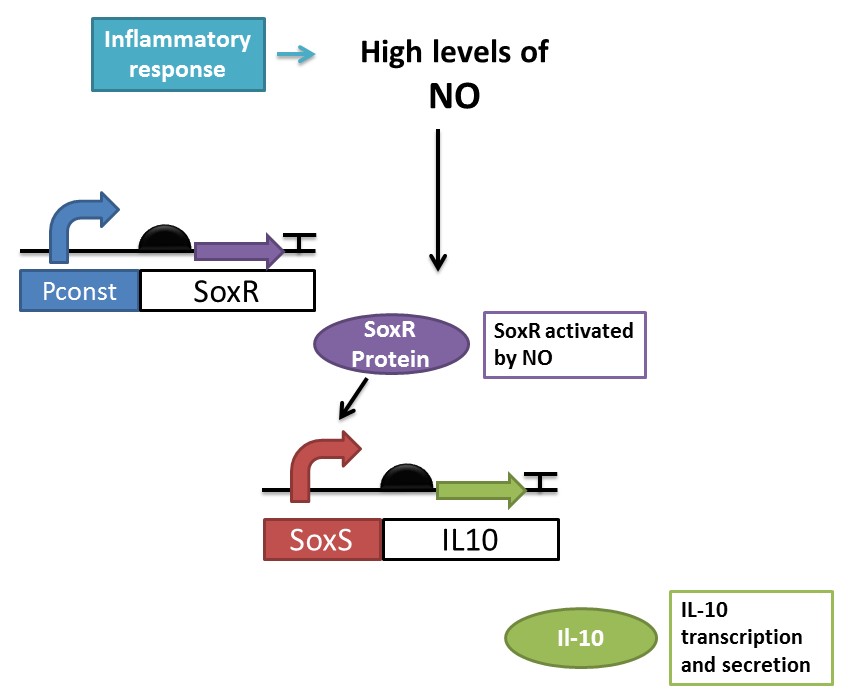Difference between revisions of "Part:BBa K554003"
Neshich.iap (Talk | contribs) (→Usage and Biology) |
Neshich.iap (Talk | contribs) (→Usage and Biology) |
||
| Line 19: | Line 19: | ||
===Usage and Biology=== | ===Usage and Biology=== | ||
| − | + | The [2Fe-2S] SoxR transcription factor a member of MerR family and is an important sensor of oxidative stress in bacteria, turning activated under presence of superoxide and nitric oxide (NO). SoxR is activated by reversible one-electron oxidation of its [2Fe-2S] cluster and in the active state, SoxR activate transcription of genes containing SoxS promoter, which have a long 19- or 20-bp spacer between the -35 and -10 operator elements, by untwisting the promoter DNA (Watanabe et al. 2008). The SoxR gene is used by [http://2011.igem.org/Team:UNICAMP-EMSE_Brazil UNICAMP-EMSE Brazil team] in the [http://2011.igem.org/Team:UNICAMP-EMSE_Brazil/Project#Device_2:_NO_sensor.2FIL-10_producer NO sensor device/ IL-10 producer] ("Device 2", which senses NO levels and responds by producing and secreting IL-10. This part is shown in the following schema: | |
[[Image:UNICAMP_EMSE_NO_device_schema.jpg|center|400px]] | [[Image:UNICAMP_EMSE_NO_device_schema.jpg|center|400px]] | ||
| + | |||
| + | You can find below a tridimensional structure of ''Escherichia coli'' SoxR protein bound to SoxS promoter (DNA structure) (retrieved from PDB 2zhg, Watanabe et al. 2008), with both p35 (chain A) and p40 (chain B) chains. This is a jmol applet, in which you can interactively see the protein format: | ||
| + | <br> | ||
| + | <div align="center"> | ||
| + | |||
| + | <html> | ||
| + | <script src="http://www.cbi.cnptia.embrapa.br/jmol/Jmol.js" type="text/javascript"></script> | ||
| + | <script type="text/javascript"> | ||
| + | jmolInitialize("http://www.cbi.cnptia.embrapa.br/jmol/"); | ||
| + | jmolApplet(400, "load http://www.cbi.cnptia.embrapa.br/jmol/files/2zhg.pdb;"); | ||
| + | jmolBr(); | ||
| + | |||
| + | jmolButton("restrict not dna; restrict not protein; restrict not HOH; restrict not ligand; dots off; selectionhalos off; center selected; zoom 100; select all; wireframe; select all; color chain; select Cu or Cu1 or Zn or fe or Ca or Cl or Mn or Mg or na or Br or SO4 or ligand; color magenta selected; cpk; select all", "Stick view", "Stick view") | ||
| + | |||
| + | jmolButton("restrict not HOH; select all; wireframe off;dots off; ribbon; color structure; zoom 100; center selected; label off; backbone off; selectionhalos off; color structure; select Cu or Cu1 or Zn or fe or Ca or Cl or Mn or Mg or na or Br or SO4 or ligand; cpk; select ligand; wireframe 75; select all; Hbonds off; SSbonds off; select ligand; ribbon off", "Ribbon view", "Ribbon view") | ||
| + | |||
| + | jmolButton("restrict not dna; restrict not protein; restrict not HOH; restrict not ligand; dots off; selectionhalos off; center selected; zoom 100; select all; wireframe; select all; color chain; backbone 50; wireframe off; select Cu or Cu1 or Zn or fe or Ca or Cl or Mn or Mg or na or Br or SO4 or ligand; cpk; select ligand; wireframe 75; select all; Hbonds off; SSbonds off; select ligand; backbone off", "Wireframe view", "Wireframe view") | ||
| + | |||
| + | jmolButton("spin y" ,"spin y"); | ||
| + | jmolButton("spin off" ,"spin off"); | ||
| + | </script> | ||
| + | </div> | ||
| + | <br /> | ||
| + | </html> | ||
===References=== | ===References=== | ||
#Hidalgo E, Leautaud V, Demple B (1998) The redox-regulated SoxR protein acts from a single DNA site as a repressor and an allosteric activator. The EMBO Journal 17(9)2629–2636 [http://www.ncbi.nlm.nih.gov/pubmed/?term=9564045%20 Link to Pubmed] | #Hidalgo E, Leautaud V, Demple B (1998) The redox-regulated SoxR protein acts from a single DNA site as a repressor and an allosteric activator. The EMBO Journal 17(9)2629–2636 [http://www.ncbi.nlm.nih.gov/pubmed/?term=9564045%20 Link to Pubmed] | ||
Revision as of 21:45, 26 September 2011
SoxR
SoxR is a transcription factor found in bacteria and is activated during superoxide or nitric oxide stress. SoxR protein in solution is a homodimer that contains two binuclear iron–sulfur clusters ([2Fe–2S]) which are then oxidized upon superoxide stress. In this form, the protein induces transcription through binding at SoxS promoter. Thus, in the presence of NO, SoxR activates transcription of the gene regulated by SoxS promoter (Hidalgo et al, 1998).
Sequence and Features
- 10COMPATIBLE WITH RFC[10]
- 12COMPATIBLE WITH RFC[12]
- 21COMPATIBLE WITH RFC[21]
- 23COMPATIBLE WITH RFC[23]
- 25COMPATIBLE WITH RFC[25]
- 1000COMPATIBLE WITH RFC[1000]
Usage and Biology
The [2Fe-2S] SoxR transcription factor a member of MerR family and is an important sensor of oxidative stress in bacteria, turning activated under presence of superoxide and nitric oxide (NO). SoxR is activated by reversible one-electron oxidation of its [2Fe-2S] cluster and in the active state, SoxR activate transcription of genes containing SoxS promoter, which have a long 19- or 20-bp spacer between the -35 and -10 operator elements, by untwisting the promoter DNA (Watanabe et al. 2008). The SoxR gene is used by [http://2011.igem.org/Team:UNICAMP-EMSE_Brazil UNICAMP-EMSE Brazil team] in the [http://2011.igem.org/Team:UNICAMP-EMSE_Brazil/Project#Device_2:_NO_sensor.2FIL-10_producer NO sensor device/ IL-10 producer] ("Device 2", which senses NO levels and responds by producing and secreting IL-10. This part is shown in the following schema:
You can find below a tridimensional structure of Escherichia coli SoxR protein bound to SoxS promoter (DNA structure) (retrieved from PDB 2zhg, Watanabe et al. 2008), with both p35 (chain A) and p40 (chain B) chains. This is a jmol applet, in which you can interactively see the protein format:
References
- Hidalgo E, Leautaud V, Demple B (1998) The redox-regulated SoxR protein acts from a single DNA site as a repressor and an allosteric activator. The EMBO Journal 17(9)2629–2636 [http://www.ncbi.nlm.nih.gov/pubmed/?term=9564045%20 Link to Pubmed]

